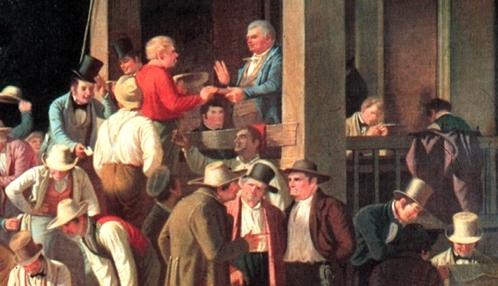A Brief Illustrated History of Voting
University of Iowa

Before Ballots
The conduct of elections has changed in many ways over the past 200 years. The extent of these changes is nicely illustrated by a comparison of today's voting practices with those illustrated in George Caleb Bingham's painting, The County Election (Figure 1). In addition to being a noteworthy artist, Bingham was a successful politician; this painting shows a polling place on the steps of the courthouse in Saline County, Missouri, in 1846. (Bingham's painting strongly resembles and was probably influended by William Hogarth's painting The Polling (or more likely, the engraving based on it) showing an election in Oxfordshire, England in 1754.
In this painting, we see the judge (top center) administering an oath to a voter. The voter (in red) is swearing, with his hand on the bible, that he is entitled to vote and has not already done so. There was no system of voter registration, so this oath and the possibility that the judge or someone else in the vicinity of the polls might recognize him if he came back was all that prevented a voter from voting again and again.
There was no right to a secret ballot; having been sworn in, the voter simply called out his choices to the election clerks who sit on the porch behind the judge tallying the vote. Each clerk has a pollbook in which he writes the voter's name and records his votes; multiple pollbooks were a common defense against clerical error. There are several people in the painting holding paper tickets in their hands. We know that these were not paper ballots because Missouri continued to use voice voting until 1863. In a general election, however, many voters might have wanted to bring their own notes to the polling place.
Campaigning at the polling place was legal and common. The man in blue tipping his hat to the voter immediately behind the man taking the oath is one of the candidates in this election, E. D. Sappington, who lost to Bingham by one vote. He's handing out his calling cards so that people can easily read off his name to vote for him.
